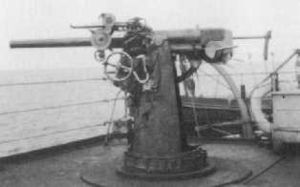- Ordnance QF 3 pounder Vickers
-
Ordnance QF 3 pounder Vickers 
On a Royal Navy monitor circa. 1918Type Naval gun, Anti-aircraft gun Place of origin United Kingdom Service history In service 1910-1940 Wars WWI, WWII Production history Designer Vickers Designed 1908 Manufacturer Vickers Produced 1910-? Number built 600 Variants Mk I Mk II Specifications Weight 1,323 lb (600 kg) in total Barrel length 8 ft 8 in (2.64 m) bore (50 calibres) Shell 47x360R. 3.3 lb (1.50 kg) shell. Calibre 47 mm (1.85 in) Breech semi-automatic vertical block Carriage three-leg platform Elevation -5° to +12° Traverse 360° Rate of fire 20 rounds per minute Muzzle velocity 2,575 ft/s (785 m/s) (HE) Effective range 2,000 yd (1,829 m)(AA) Maximum range 5,600 yd (5,100 m) at 12° elevation;
15,000 ft (4,600 m) (AA ceiling)Sights telescopic The Ordnance QF 3 pounder Vickers was a British artillery piece first tested in Britain in 1910. It was used on Royal Navy warships. It was more powerful than and unrelated to the older QF 3 pounder Hotchkiss, with a propellant charge approximately twice as large, but it initially fired the same Lyddite and Steel shells as the Hotchkiss.[1]
Contents
Development
Starting in 1914, the Royal Navy bought over 150 of these for use as anti-torpedo boat weapons on capital ships and to arm light craft. British production of these guns started in 1910 at Vickers and by the time production stopped in 1936 a total of 600 weapons had been made.


RNAS gun on improvised anti-aircraft mounting, Tenedos, Dardanelles, 1915. Photo by Ernest Brooks. By 1911 about 193 guns of this type were in service, and they became standard equipment in the Royal Navy until 1915. In that year, service during the First World War proved these weapons to be ineffective and they were quickly removed from most of the larger ships. During the interwar years they were widely used to arm light ships and river craft. A number of them were converted into anti-aircraft guns and by 1927 at least 62 guns had been converted.
References
- ^ Treatise on ammunition 10th Edition 1915. War Office, UK. Page 404
See also
- QF 3 pounder Hotchkiss : this gun's predecessor
- List of naval guns
- British standard ordnance weights and measurements
External links
Monitor guns BL 9.2 inch Mk VI · BL 9.2 inch Mk VIII · BL 9.2 inch Mk X · BL 9.2 inch Mk XII · BL 12 inch Mk VIII · US 14 inch 45 cal · BL 18 inch Mk I
Capital ship main armament Vickers 10 inch 45 cal · EOC 10 inch 45 cal · BL 12 inch Mk VIII · BL 12 inch Mk IX · BL 12 inch Mk X · BL 12 inch Mk XI & XII · EOC 12 inch 45 cal Mk XIII · BL 13.5 inch Mk V · EOC 14 inch 45 cal Mk I · BL 15 inch Mk I
Armoured cruiser main armament BL 7.5 inch Mk I · BL 9.2 inch Mk X · BL 9.2 inch Mk XI
Secondary armament &
light cruiser main armamentQF 12 pdr 18 cwt · QF 14 pounder · QF 4 inch Mk III · BL 4 inch Mk VII · QF 4 inch Mk V · BL 4 inch Mk IX · BL 5.5 inch Mk I · QF 6 inch · BL 6 inch Mk VII · BL 6 inch Mk XI · BL 6 inch Mk XII · BL 6 inch Mk XIII-XVIII · BL 7.5 inch Mk II - Mk V
Destroyer & small cruiser armament QF 12 pdr 12 cwt · QF 4 inch Mk III · BL 4 inch Mk VIII · QF 4 inch Mk IV · BL 4.7 inch Mk I
Merchant ship armament QF 4.7 inch Mk I - IV · QF 4.7 inch Mk V*
Submarine guns Anti-aircraft guns Light weapons .303 Vickers machine gun · QF 3 pounder Hotchkiss · QF 3 pounder Vickers · QF 6 pounder Hotchkiss
Torpedoes 18 inch Mk V - VIII · 21 inch Mk II · 21 inch Mk IV
Mines Spherical Mk I, II and III · Vickers Elia mine · Type H mine
Anti-submarine weapons Type D Depth charge · 7.5 inch howitzer
Landing guns Categories:- 47 mm artillery
- World War I artillery of the United Kingdom
- Vickers
- Naval anti-aircraft guns
- Naval artillery
- Naval guns of the United Kingdom
Wikimedia Foundation. 2010.
